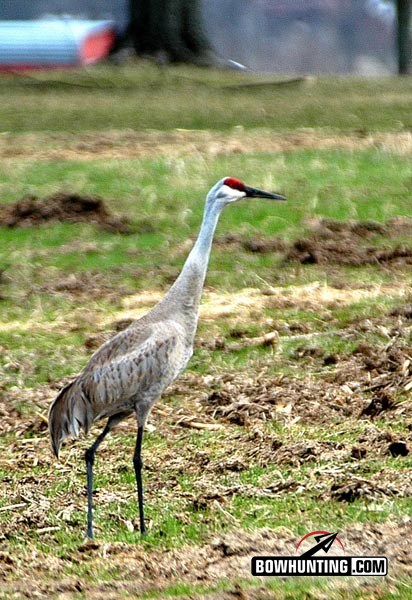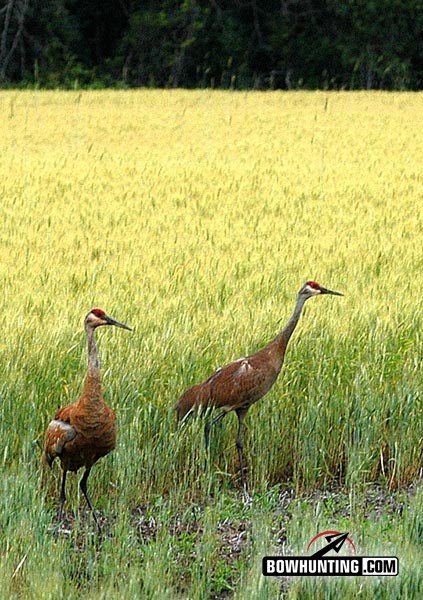LAST UPDATED: May 8th, 2015
Deer hunting sparks some of the ugliest political fights you’ll ever see, whether it concerns antlerless hunts, deer baiting or opening our archery season to crossbows.
But to see true culture clashes, nothing compares to efforts to open hunting seasons on mourning doves or sandhill cranes. OK, wolves too. But that’s another blog.
Sandhill cranes and Canada geese feed in a central Wisconsin field.
There’s no reasoning with many folks from the birding community when you calmly note their opposition lacks logic. Take Wisconsin, for example. You’d expect that with nine humdrum mourning dove seasons behind us that Wisconsinites could politely discuss a hunt for sandhill cranes.
But no. Mention a sandhill hunt, and folks still cock their fists and get sideways, even though no one’s life crumbled from dove hunting. No one seems to remember that spite vanished like spiced dove breasts on hor devours trays after dove season opened in 2003.
Likewise, if we established a sandhill crane season tomorrow, we’d be yawning by Labor Day. But in proposing a crane hunt this past winter, Rep. Joel Kleefisch, R-Oconomowoc, did Wisconsin hunters no favors by citing crop damage as a hunting justification.
If foraging cranes trouble Kleefisch and his fellow legislators, why did they abolish earn-a-buck rules for deer hunting? No critter rivals deer for damaging crops and plants, and no program whacked whitetails like earn-a-buck.
Sandhill cranes are distinguished by their red-capped head.
In killing EAB, lawmakers parroted my fellow hunters who claimed there aren’t enough deer, and that hunters aren’t pest-control officers. But when the Associated Press asked Marshfield’s Marlin Laidlaw, chairman of the Wisconsin Conservation Congress’s agricultural damage committee, about Kleefisch’s proposal, Laidlaw said sandhill cranes are out of control:
“The problem with the people who don’t understand wildlife and wildlife management, they join an organization and fall in love with a particular species. As far as they’re concerned, you can’t have too many. They just don’t get it. You’ve got to control populations.”
Hmm. Was Laidlaw talking about sandhill cranes or white-tailed deer? For years he loudly opposed EAB and the Department of Natural Resources’ efforts to reduce deer numbers.
We can agree, however, that most people don’t hunt to provide the public free pest-control services. We hunt because it’s exciting and challenging, and provides lean free-range meat no store can match. Granted, when the DNR regulates hunting to prevent critters from becoming a danger or nuisance, that’s a bonus; even a necessity. But it doesn’t motivate most hunters.
Sandhill cranes can be viewed as both a majestic bird and great table fare.
Meanwhile, protectionists neither help cranes nor their cause by blindly opposing a hunt. Karen Etter Hale, a vice president of Wisconsin’s Audubon Council, told the AP: “If hunters want to further damage their reputation by pushing for yet another species to hunt, then that’s what they should do.”
Yep, that’s right. Stay on your side of the tracks, people. Folks like Etter Hale said the same thing about dove hunting in Wisconsin a decade ago. But a hunting season for a plentiful, large-bodied, good-eating bird isn’t about reputations. It’s about reminding our timid DNR of its historical mission to promote public hunting and fishing when self-sustaining species can provide meat, fur and recreation.
Meanwhile, Madison’s Audubon Society posted a “Sandhill Crane Hunt Alert” on its Web site, encouraging members to contact legislators.
Sigh. Why do people with similar goals hate working together? Hunters and bird-huggers both donate to habitat-conservation causes. Both smile and perk their ears at goose music and crane bugles. And both quote Aldo Leopold more than the Bible.
Well, here’s a Leopold quote bird-folks ignore: “Game management is the art of making land produce sustained annual crops of wild game for recreational use.”
That’s the opening sentence of Leopold’s seminal book “Game Management,” which guided North America’s efforts to replenish the birds and mammals we nearly wiped out 100 years ago through unregulated development, market hunting and subsistence hunting.
In Leopold’s spirit, Etter Hale, Laidlaw and other conservation leaders should seize crane hunting as a chance to work together. First, they should join forces to establish the season, and require hunt applicants to pay $15 and those receiving a permit to pay $25 more. If opponents don’t like hunting, they can apply for permits and burn what they receive.
Next, the state could earmark fees for the International Crane Foundation, and equal amounts for the DNR’s endangered resources bureau, which needs help. Its 2011 budget was $5.9 million, most of it from donations.
That’s only 12 percent of the Wisconsin DNR’s combined budgets for its fisheries bureau, $26.5 million; and wildlife bureau, $21 million. Most of those budgets are funded by anglers, trappers and hunters.
Birders should be emulating that generosity rather than demanding government impose their values on everyone. Besides, as Leopold proved, people can be both hunters and bird-lovers. They can see sandhill cranes both as majestic birds and flying rib-eyes. They acknowledge — and embrace – life’s apparent contradictions.
The great ones, like Leopold, make it look easy.

 By
By 





